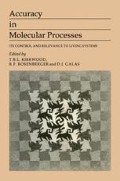Abstract
The primary concern of this book is about how cells copy and maintain the information which is stored as base sequences in their DNA and how they use this information to specify the structure of proteins. It is generally accepted that these processes of information transfer are the most essential and basic functions any living organism has to perform.
Access this chapter
Tax calculation will be finalised at checkout
Purchases are for personal use only
Preview
Unable to display preview. Download preview PDF.
References
Alberts, B. and Sternglanz, R. (1977) Recent excitement in the DNA replication problem. Nature, 269, 655–661.
Baldwin, A. N. and Berg, P. (1966) Transfer ribonucleic acid-induced hydrolysis of valyl adenylate bound to isoleucyl ribonucleic acid synthetase. J. Biol. Chem., 241, 839–845.
Bessman, M., Muzyczka, N., Goodman, M. and Schnaar, R. (1974) Studies on the biochemical basis of spontaneous mutation. II The incorporation of a base and its analogue into DNA by wild-type, mutator, and anti-mutator DNA polymerases. J. Mol. Biol., 88, 409–421.
Brutlag, D. and Kornberg, A. (1972) Enzymatic synthesis of DNA: a proofreading function for the 3′ to 5′ exonuclease activity in DNA polymerases. J. Biol. Chem., 247, 241–248.
Clayton, L., Goodman, M., Branscomb, E. and Galas, D. (1979) Error induction and correction by mutant and wild-type T4 DNA polymerases: kinetic error discrimination mechanisms. J. Biol. Chem., 254, 1902–1912.
Eisley, L. (1958) Darwin’s Century. Doubleday, New York.
Eldred, E. W. and Schimmel, P. R. (1972) Rapid deacylation by isoleucyl tRNA synthetase of isoleucine specific tRNA aminoacylated with valine. J. Biol. Chem., 247, 2961–2968.
Galas, D. and Branscomb, E. (1978) The enzymatic determinants of DNA polymerization accuracy: theory of T4 polymerase mechanisms. J. Mol. Biol., 124, 653–687.
Grosjean, H., de Henau, S. and Crothers, D. (1978) On the physical basis for ambiguity in genetic coding interaction. Proc. Natl Acad. Sci. USA, 75, 610–614.
Guéron, M. (1978) Enhanced selectivity of enzymes by kinetic proofreading. American Scientist, 66, 202–208.
Hopfield, J. J. (1974) Kinetic proofreading: a new mechanism for reducing errors in biosynthetic processes requiring high specificity. Proc. Natl Acad. Sci. USA, 71, 4135–4139.
Jencks, W. P. (1975) Binding energy, specificity and enzyme catalysis: the circe effect. Advances Enzymol., 43, 219–410.
Kirkwood, T. B. L. (1977) Evolution of ageing. Nature, 270, 301–304.
Kirkwood, T. B. L. (1981) Repair and its evolution: survival versus reproduction. In Physiological Ecology: An Evolutionary Approach to Resource Use (eds C. R. Townsend and P. Calow ), Blackwell, Oxford, pp. 165–189.
Kirkwood, T. B. L., Hoiliday, R. and Rosenberger, R. F. (1984) Stability of the cellular translation process. Int. Rev. Cytol., 92, 93–132.
Lipscomb, W. N. (1978) Intramolecular interactions, enzyme activity and models. In Molecular Interaction and Activity in Proteins, Ciba Foundation Symposium 60, Amsterdam.
Loftfield, R. B. (1963) The frequency of errors in protein biosynthesis. Biochem. J., 89, 82–87.
Ninio, J. (1975) Kinetic amplification of enzyme discrimination. Biochimie, 57, 587– 595.
Ninio, J. (1982) Molecular Approaches to Evolution, Pitman, London.
Nossal, N. and Hershfield, M. (1973) Exonuclease activity of wild-type and mutant T4 DNA polymerases: hydrolysis during DNA synthesis in vitro. In DNA Synthesis In Vitro (eds R. Wells and R. Inman ), University Park Press, Baltimore.
Ofengand, J. (1977) tRNA and aminoacyl-tRNA synthetases. In Molecular Mechanisms of Protein Biosynthesis (eds H. Weissbach and S. Pestka) Academic Press, New York, pp. 7–79.
Orgel, L. E. (1963) The maintenance of the accuracy of protein synthesis and its relevance to ageing. Proc. Natl Acad. Sci. USA, 49, 517–521.
Pauling, L. (1957) The probability of errors in the process of synthesis of protein molecules. In Festschrift Arthur Stoll, Birkhauser Verlag, Basel, pp. 597–602.
Rossett, R. and Gorini, L. (1969) A ribosomal ambiguity mutation. J. Mol. Biol., 39, 95–112.
Schrödinger, E. (1944) What is Life?, Cambridge University Press, Cambridge.
Steege, D. and Söll, D. (1979) Suppression. In Biological Regulation and Development. 1. Gene Expression (ed. R. F. Goldberger ), Plenum, New York, pp. 433–486.
Weiss, R. and Gallant, J. A. (1983) Mechanism of ribosome frameshifting during translation of the genetic code. Nature, 302, 389–393.
Woese, C. (1970) Molecular mechanism of translation: a reciprocating ratchet mechanism. Nature, 226, 817–820.
Wolpert, L. (1981) Positional information and pattern formation. Phil. Trans. R. Soc. Lond. B, 295, 441–450.
Yarus, M. (1972a) Solvent and specificity. Binding and isoleucylation of phenylalanine tRNA (E. coli) by isoleucyl-tRNA synthetase from E. coli. Biochemistry, 11, 2352–2361.
Yarus, M. (1972b) Phenylalanyl-tRNA synthetase and ile-tRNAphe: a possible verification mechanism for aminoacyl-tRNA. Proc. Natl Acad. Sei. USA, 69, 1915–1919.
Editor information
Editors and Affiliations
Rights and permissions
Copyright information
© 1986 Chapman and Hall
About this chapter
Cite this chapter
Galas, D.J., Kirkwood, T.B.L., Rosenberger, R.F. (1986). An introduction to the problem of accuracy. In: Kirkwood, T.B.L., Rosenberger, R.F., Galas, D.J. (eds) Accuracy in Molecular Processes. Springer, Dordrecht. https://doi.org/10.1007/978-94-009-4097-0_1
Download citation
DOI: https://doi.org/10.1007/978-94-009-4097-0_1
Publisher Name: Springer, Dordrecht
Print ISBN: 978-94-010-8318-8
Online ISBN: 978-94-009-4097-0
eBook Packages: Springer Book Archive

